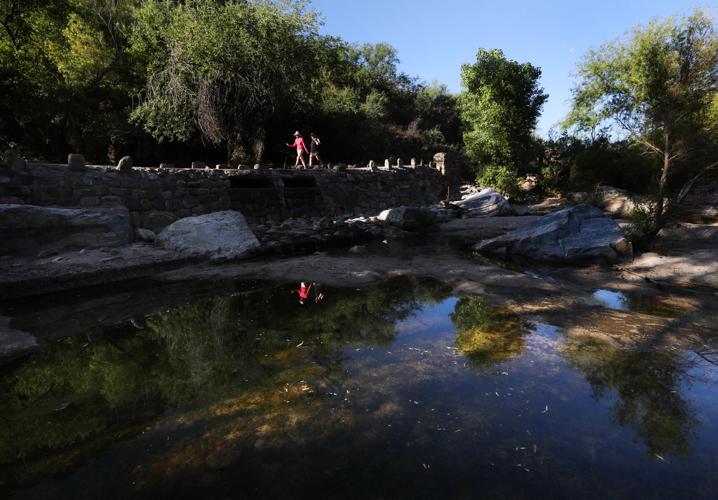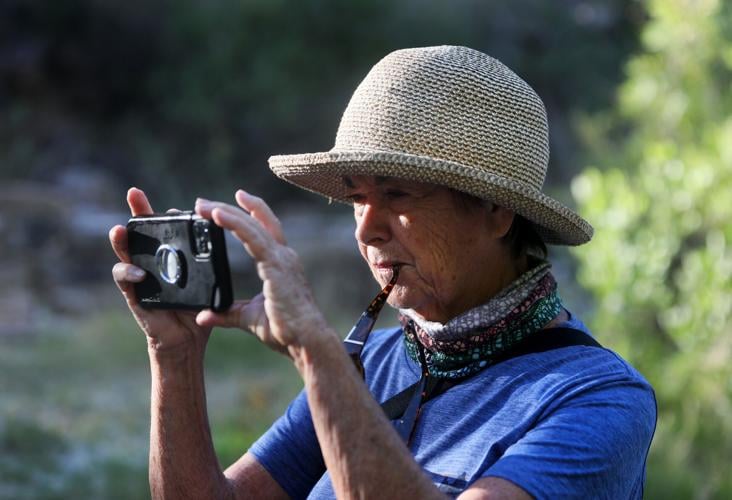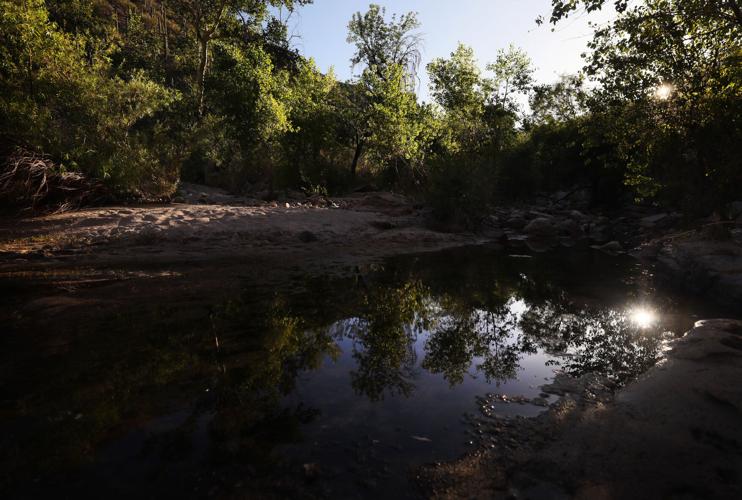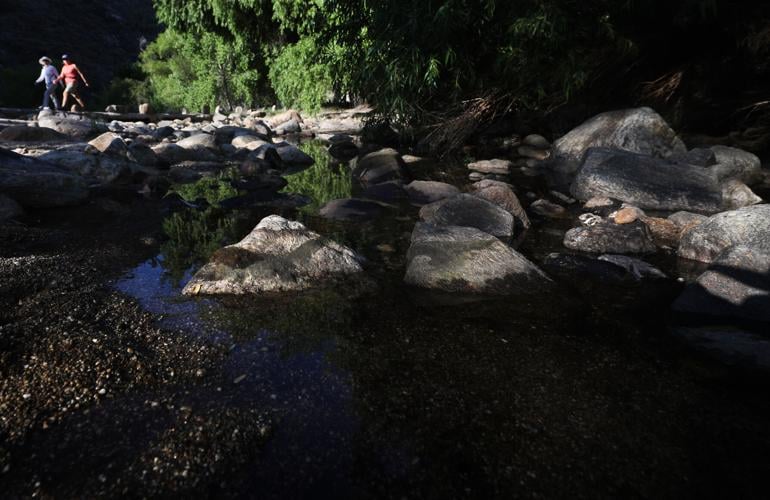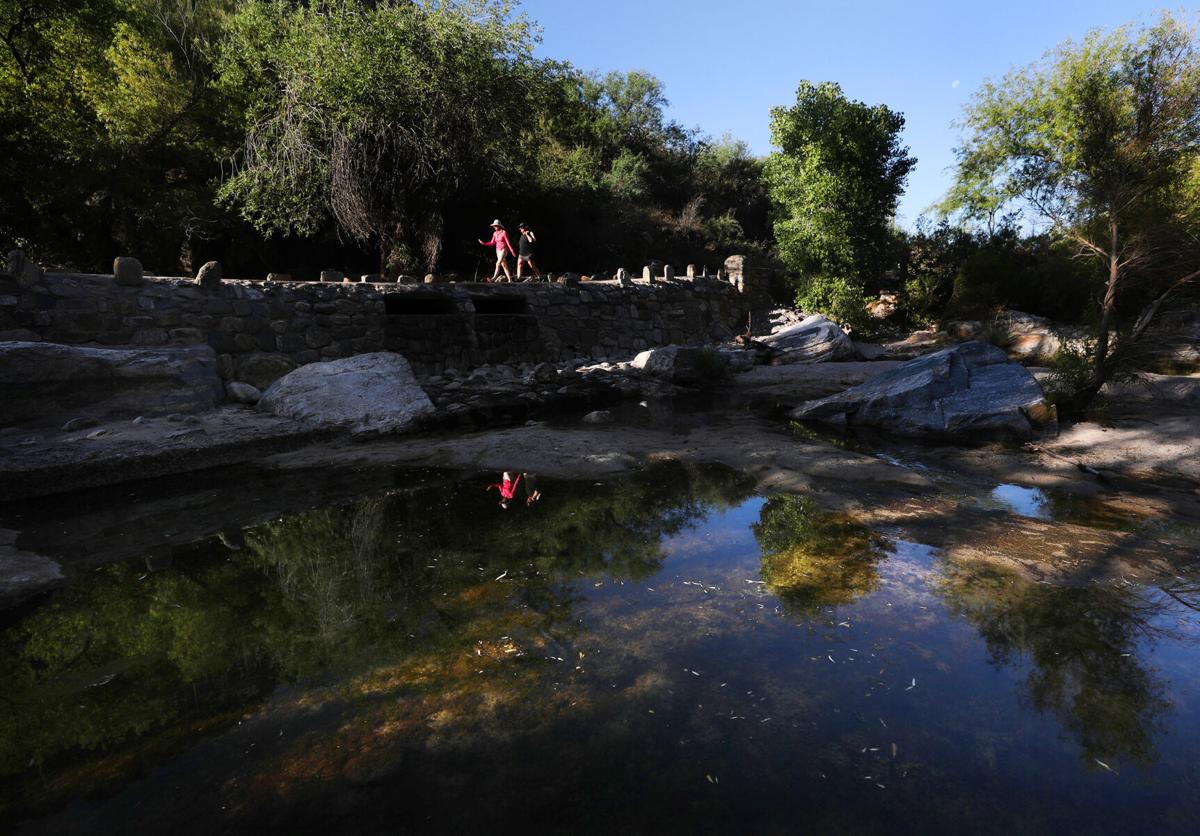A ribbon of water trickled Wednesday morning through an opening in a rock-walled crossing of Sabino Creek, along the paved road winding through Sabino Canyon.
The water first radiated outward in circular fashion, then came to rest in a large pool, maybe 40 feet long and 20 to 30 feet across. Tiny minnows circled around just under the surface; all appeared to be endangered Gila chub, says retired federal fish biologist Jeff Simms.
Upstream of the crossing, the creek formed a smaller pool. White-wing doves cooed their usual "Who cooks for you?" call, as a breeze wafted through the branches of cottonwood and willow trees towering along both sides of the water.
The sight of water running in the creek at all in early June or even late May startled Janet Marcotte. She has lived near and regularly walked the canyon for 32 years. Marcotte has no recollection of seeing any water at the creek's first bridge, lying about 500 feet upstream of the crossing, this late in Tucson's normally dry spring except for this year and last year.
Typically, the creek is at its driest in late spring, when Tucson normally has its driest weather, in between its winter rains and summer monsoons.
This year's rainfall, however, is running nearly 30% above normal, putting more water than normal into not only Sabino Creek but several others, including the Rillito River, Tanque Verde Creek and Bear Creek, a tributary to Sabino Creek, federal records show.

Janet Marcotte takes a photo of the scenery while on one of her early morning walks through Sabino Canyon this week. Marcotte has been walking Sabino Canyon for 32 years and observes the changes in water in the creek and near the bridges. She says the water is usually dried up between April and May, and that this is one of the latest times of year she’s seen water.
Last year's rainfall was well below normal. But rainfall just in December 2022 was almost one-third of an inch above normal, giving a head start to this year's flows in Tucson's seasonal watercourses.
Continuous 100-day flows
Besides the findings of official, federal stream gauges, volunteers for a nonprofit group who monitor many Tucson-area streams saw continuous flow for at least 100 days this year in three — the Rillito, Bear Creek and Aqua Caliente Creek.
The flows were recorded for the Watershed Management Group, which has long advocated for preserving and enhancing stream flows and for reducing groundwater pumping to allow streams to flow more often.
The continuous 100-day flows have never happened before on those three creeks during the group's eight years of monitoring, said Laura Monheim, manager of the group's River Run Network. "It's definitely a record," she said. "It's really incredible, really impressive, for sure."
"Running water always makes it wonderful; just to have it so much longer in the year is fantastic," said Marcotte, a retired executive director of the YWCA of Southern Arizona.
Her observations are backed up by formal statistics, recorded in a U.S. Geological Survey stream gauge located about 40 feet above Sabino Dam, a rock structure a few hundred yards downstream of the paved Sabino Canyon Road.

Water is seen near bridge two in Sabino Canyon on June 7. Sabino Creek is running much later than normal this year. Water is usually dried up between April and May.
This year, average monthly flows at the gauge have exceeded the monthly averages covering the period 1991 through 2022 for every month except April. Sabino also ran continuously for an extended period both this and last year, from July 27, 2022 until June 1 at the U.S.G.S. stream gauge site.
Looking farther back, this year's average monthly flows were less than those averaged over 35 years, from 1987 through 2022. But that's most likely because many years in the 1980s and 1990s were much wetter than most years have been since the Southwest's long-term drought started around 2000.
Because it's drier now than it was 25 or 30 years ago, the creek's average date for drying up was June 3 from 2015 through 2022, compared to a longer-term average drying date of June 23, said Kurt Ehrenberg, U.S.G.S.'s Tucson field office chief.
'It's been flowing without stop'
This year's Sabino flows also stand in marked contrast from those of 2020, Tucson's driest year on record.
That year, the creek ran dry 216 days, including 136 straight dry days from late summer through the fall, the federal agency's records show. That was the longest consecutive stretch of dry days since the U.S.G.S. started keeping records at Sabino in the 1980s.
But looking at this year's flows, Marcotte said she had been struck by the strength of the creek's flow during the last week of May because "I could hear it just as I dipped into the canyon ... a mile before I even got to the first bridge.
"By early August 2022, there was so much water, the bridges were not safe to cross and it’s been flowing without stop at least since then," said Marcotte, who today walks the canyon three days a week. "When I went there first week of April of 2023, it was the first time this year I didn’t have to wade in water all over the bridges."
On Tanque Verde Creek, water ran continuously at its U.S.G.S. stream gauge near Sabino Canyon Road from Dec. 31, 2022, through April 15 of this year.
Its monthly average flows at the gauge were higher than their 21st-century averages in January, February and March, the only months this year for which such data is yet available. Its January 2023 flow was the highest flow for that month on the creek since the start of the 21st century, U.S.G.S. records show. March 2023 saw the third-highest March flow on record in this century, and the February 2023 flow was the sixth-highest for that month.
At U.S.G.S.' Rillito River gaging station at Dodge Road, the January 2023 flow was by far its highest for January this century. The February flow, the only other one for 2023 for which data is available, was also above normal and was its fifth-highest flow since 2000. The Rillito flowed continuously from Jan. 1 through Jan. 27 and from Feb. 22 until March 26.
Upstream at Craycroft Road, where the Pantano Wash and Tanque Verde Creek merge to form the Rillito, the river ran continuously for 107 days until drying on April 18, Monheim said. That's "the most we've ever seen" in eight years of monitoring on the Rillito, she said.

Early morning hikers walk over the first bridge at Sabino Canyon as water still runs through on June 7. Sabino Creek is running much later than normal this year. Water is usually dried up between April and May.
At the group's informal monitoring spot at the Bear Creek trailhead near Sabino Creek, water was running down Bear Creek for 120 consecutive days before it dried up on May 3. Aqua Caliente Creek at Milagrosa Lane ran 100 days before drying on April 11, Monheim said.
Where the group monitors Tanque Verde Creek at Wentworth Road, it's flowed continuously for 153 days from Jan. 4 through Wednesday, June 7, said Monheim, adding, "We're hopeful that we can see it all the way into the monsoons. That would be cool."
Watershed Management Group has 70 volunteers who collect river flow data annually at 40 spots across the Tucson area, she said.
"This water year, I would definitely describe it as encouraging. I think it’s definitely due to the awesome winter rains we had this year that we had this much flow," Monheim said.
Photos: Sabino Canyon through the years

Men on horseback in Sabino Canyon north of Tucson, ca. 1950s.

A camping trip in Sabino Canyon by a company of Military students from the UA and Capt. Maxon in December 1903.

Sabino Canyon in 1904.

Sabino Canyon, March 25, 1911.

Sabino Canyon in 1912.

Fishing for trout in Lower Sabino Canyon in May, 1951.

Sabino Creek at Sabino Canyon Recreation Area north of Tucson, probably ca. 1950s.

A dry Sabino Creek at Sabino Canyon Recreation Area north of Tucson, probably ca. 1950s.

Undated photo of snow at Sabino Canyon Recreation Area north of Tucson. Probably ca. 1950s.

Undated photo of snow at Sabino Canyon Recreation Area north of Tucson. Probably ca. 1950s.

Fishing in Sabino Creek at Sabino Canyon Recreation Area north of Tucson. Probably ca. 1950s.

Cookout at Sabino Canyon Recreation Area north of Tucson, ca. 1950s.

Undated photo of Sabino Canyon, probably 1950s. at Sabino Canyon Recreation Area north of Tucson.

Construction crews work to deepen the lake in Sabino Canyon north of Tucson in March, 1951.

A boy fishes in the lake at Sabino Canyon north of Tucson in May, 1951, after it was stocked with trout for the first time.

People fish in the lake at Sabino Canyon north of Tucson in May 1951, after it was stocked with trout for the first time. Photo credit: Arizona Daily Star

Water gushes over the entire 90-foot width of the Lower Sabino Dam at Sabino Canyon Recreation Area north of Tucson in March, 1954, after a steady two-day rain. It was the heaviest flow over the dam since 1932.

Sabino Creek at Sabino Canyon Recreation Area north of Tucson in March, 1956.

A U.S. Geological Survey employee checks water level several hundred yards upstream from Lower Sabino Dam in 1956 at Sabino Canyon Recreation Area north of Tucson.

Sabino Canyon on Nov. 4, 1963.

The yet-unfinished Sabino Canyon gatehouse, about a half mile away from the Visitor Center, was several days away from completion on September 2, 1969. The roadway throughout the area was repaved causing some temporary closing of certain recreation sites.

Civilian Conservation Corps workers make adobe bricks in lower Sabino Canyon.

Heavy rains produced a sizeable flow through Sabino Canyon on Dec. 29, 1972. Forty-four people were evacuated from the canyon area and search teams rescued a 15-year-old from floodwaters. Photo by Bruce Hopkins / Tucson Citizen

Undated photo of rocks in Sabino Creek at Sabino Canyon Recreation Area north of Tucson.

Filming the television series "Gunsmoke" in Lower Sabino Canyon. April 23, 1973.

Hundreds of cars parked haphazardly along Sabino Canyon Road outside Sabino Canyon National Recreation Area north of Tucson in March, 1974, before the parking lot was expanded and vehicles were banned from the canyon.

Cars parked haphazardly along Sabino Canyon Road outside Sabino Canyon National Recreation Area north of Tucson in March, 1974, before the parking lot was expanded and vehicles were banned from the canyon.

People jump into Sabino Creek at the Sabino Canyon National Recreation Area north of Tucson in September, 1981.

A shuttle bus ferries passengers into Sabino Canyon National Recreation Area north of Tucson in June, 1978. The service was offered only in Upper Sabino until more trams were delivered. Vehicles were banned permanently in 1981.

Sabino Canyon National Recreation Area north of Tucson in September, 1981.

A tram loaded with passengers crosses Sabino Creek in Sabino Canyon National Recreation Area north of Tucson in September, 1981.

People play volleyball in the "lake" behind the dam on Sabino Creek at Sabino Canyon National Recreation Area north of Tucson in September, 1981.

Maria Reyna, left, and friend Gena Vidal cool off in a pool at Sabino Canyon National Recreation Area north of Tucson during record heat on June, 26, 1990.

Maria Reyna, left, and friend Gena Vidal have a water fight in a pool at Sabino Canyon National Recreation Area north of Tucson during record heat on June, 26, 1990.

Neil Meicke enjoys his day off as an electrician to take advantage of some cool water at Sabino Canyon north of stop #8 just about a 1/4 mile from the top of the Canyon. Meicke was there with his wife Terrie Meicke and daughter Caitlin, age 5. Photo taken in May, 1997.

Water and winter visitors roll through Sabino Canyon...One day after rains drenched Tucson, the weather was good enough to lure tramloads of visitors yesterday to Sabino Canyon, where water deposited by recent storms ran freely in Feb., 1998.

Early evening walkers climb the hill leading out of Sabino Canyon as the summer sky turns to night in July, 1998.

Jason Poore of Louisville, Kentucky, jumps from a rockface in an area known as the "crack" a popular water hole in Sabino Canyon between stops #8 and #9, in Aug. 2000.

U.S. Forest Service crews clear debris and destroyed chunks of roadway from the road above the second creek crossing in Sabino Canyon in July, 1999.

Stephanie Garmon and Ray Lilly make their way over a Sabino Canyon bridge after a torrential rain in July, 1999.

Bob Keeler and his 11-year-old son John enjoy cool water from recent storms flowing over the lower Sabino Canyon dam in July, 1999.

Todd Craven and his brother Scott Craven remove a log from the lower Sabino Canyon area in July, 1999. Volunteers helped clean up the debris that was scattered all over Sabino Canyon after heavy rain.

Out for a cool walk in the park. That is just what these folks are doing as they are getting their exercise in by walking in and out of the Sabino Canyon area in August, 2000.

Pleasant Valley Hotshots make their way toward a waiting helicopter to take them to Rattlesnake Ridge to fight a lightning-caused fire in June, 2000.

A saguaro is sillouetted as the Rattlesnake Ridge fire rages down the southern side of the Santa Catalina Mountains near Sabino Canyon on June 7, 2000.

Rogan Cudworth plays in the water at Sabino Canyon's "The Crack" area, a popular area because of running water and sand-like beaches, in March, 2000.

Sabino Canyon Visitors walk up the road as the vivid color of the sunset glows in the background February 24, 2002.

This mountain lion, shown in May, 2004, which was captured near Sabino Canyon, might have died had she not been caught.

A tram carries passengers across a bridge as a high-flowing Sabino Creek tumbles by in Sabino Canyon on August 9, 2010.

Water from a high-flowing Sabino Creek rolls past a small tree in Sabino Canyon in Tucson, Ariz., August 9, 2010.

Mountain bikers take advantage of the beautiful scenery in the upper Sabino Canyon/Aspen Draw area in the Catalinas. Photo taken 9/26/10.

Reddish brown ferns show the start of autumn color in upper Sabino Canyon/Aspen Draw area in the Catalinas. Photo taken 9/26/10

Visitors walk and run into Sabino Canyon early in the morning on December 28, 2011, in Tucson, Ariz. The local residents usually arrive early to exercise for their wellness, said Larry Pratt, a recreation project manager with the US Forest Service.

Alison Matson gets come help from Alex Decker as they both cross the creek in Sabino Canyon on December 28, 2011, in Tucson, Ariz. Residents and winter visitors come to Sabino during the Holiday break to walk, run or bicycle for their general wellness, get close to nature, ride the shuttle or search for some peace and quiet.

An animated Dan Granger, a Sabino Canyon volunteer naturalist, holds a bobcat during a puppet show he performed in front of children and adults at the annual Music in the Canyon by the Friends of Sabino Canyon March 6, 2011.

Shuttle driver Janell Gardner works her way through a traffic jam down Sabino Canyon as she follows one shuttle and slides by another going up the canyon on Wednesday, December 28, 2011, in Tucson, Ariz. What Gardner likes most about driving through the canyon, is the canyon itself. Residents and winter visitors come to Sabino during the Holiday break to walk, run or bicycle for their general wellness, get close to nature, ride the shuttle or search for some peace and quiet.

Members of the group, the Desert Sons performed at the annual Music in the Canyon by the Friends of Sabino Canyon on March 6, 2011, in Tucson, Ariz. There was music, food, raffles, and activities for children at the event.

Dave Konigsberg and family make their way along the Blackett's Ridge Trail trail in Sabino Canyon on, November 8, 2011.

A full moon rises above a saguaro forest on the Blackett's Ridge Trail trail in Sabino Canyon on November 8, 2011.

Large boulders are seen near tram stop number 2 at Sabino Canyon on April 11, 2011 in Tucson, Ariz. Large boulders, like these near Tram Stop 2 in Sabino Canyon, likely tumbled from higher in the canyon at some unknown time in the past during a rock fall or landslide. Sometime in the distant future, they will be worn down to pebbles and sand and washed out of the canyon.

A rock flow seen at the end of the tram route at stop 9 at Sabino Canyon on April 11, 2011 in Tucson, Ariz. This dramatic debris flow, a result of a powerful 2006 flood in Sabino Canyon, is near Tram Stop 9 at the end of the canyon road. For an April 17 Vamos cover story, we plan to describe and show a sort of self-guided tour of geologic sites visible along the road in Sabino Canyon.

A hiker makes his way through rock formations near tram stop 8 at Sabino Canyon on April 11, 2011 in Tucson, Ariz. hiker navigates an expanse of gneiss rock near Tram Stop 8 in Sabino Canyon. It's a site where pockets and natural tanks in the rock sometimes hold water from rainfall or high stream flows.

Randy Strissel and Glenna Strissel of Marysville, Tennessee, walk among rocks where water would normally be flowing near tram stop #8 in Sabino Canyon on July 5, 2012.

A Coues White-tailed deer pauses right next to the road at Sabino Canyon. Whether it is on the road or along a trail, there are plenty of sights to please and entice the senses. The photo was taken in Tucson, Ariz., on Tuesday, Nov. 24, 2015.

A walker begins the long drop into Sabino Canyon which can be a good choice to as a means to work off those Thanksgiving dinner calories. Whether it is on the road or along a trail, there are plenty of sights to please and entice the senses. The photo was taken in Tucson, Ariz., on Tuesday, Nov. 24, 2015.

Saguaros are on a blooming binge in Sabino Canyon northeast of Tucson. Photo taken on May 13, 2016.

Korean middle school student Heidi Choi Hyun Hee, 13, documents her experience crossing a Sabino Creek in Jan., 2016, while taking a tram as she and fellow students explore the canyon. Students from Magee and Secrist Middle Schools and Safford K-8 Magnet School joined the Korean students as they took a tram up Sabino Canyon then stopped to have lunch then wander around the area.

Hikers trek a tree-shaded trail in the Upper Sabino Canyon area high in the Catalina Mountains north of Tucson on June 5, 2016.

Monsoon rains have brought vibrant green hues to the deserts of Sabino Canyon on September 8, 2016.

A group of women stand on a bridge as they watch one of their party walk into the creek at Sabino Canyon National Recreation Area in Tucson, on August 7, 2016.

Ron Gonzales walks over a water-covered bridge at Sabino Canyon National Recreation Area as he gives his wife Mary a piggyback ride in Tucson, on August 7, 2016.

Snow melt from Mt. Lemmon has made its way down into Sabino Canyon filling up Sabino creek with water on January 11, 2017.

Visitors admire the water in Sabino Creek at the first crossing aboard the Sabino Canyon Tours tram at Sabino Canyon, 5700 N. Sabino Canyon Road, on Aug. 31, 2017, in Tucson, Ariz.

Naomy Robles, 7, sits atop dad Raul's shoulder while they bask in the water cascading over Sabino Dam as visitors to Sabino Canyon enjoy a cooling-off in the abundant monsoon runoff flow near the Sabino Dam in 2017.

With creek levels low, Mie Welsch, right, and 12-year-old daughter Jamie are able to traverse the route across Sabino Creek south of the dam as Autumn color still clings to the branches on trees dotting Sabino Creek at Sabino Canyon Recreation Area, 5900 N. Sabino Canyon Road, on Jan. 5, 2018, in Tucson, Ariz.

Autumn color still clings to the branches on trees dotting Sabino Creek at Sabino Canyon Recreation Area, 5900 N. Sabino Canyon Road, on Jan. 5, 2018, in Tucson, Ariz.

Young girls toe the slippery rocks at the Sabino Dam at Sabino Canyon Recreation Area, 5700 N. Sabino Canyon Road, on March 8, 2018, in Tucson, Ariz. The creek is finally flowing with winter runoff following more than 150 days of dry conditions.

Santa Catalina Volunteer Patrol volunteer Marty Horowitz, helps a group of visitors with trail information at Sabino Canyon Recreation Area, 5700 N. Sabino Canyon Road, Jan. 4, 2019, in Tucson, Ariz. Volunteers with the SCVP have helped Sabino Canyon visitors with trail information and general assistance amid the partial government shutdown.

A hiker reaches the rocky top of Blackett's Ridge in Sabino Canyon.

Hikers make their way along Sabino Creek as the first hints of autumn color appear in Sabino Canyon.

Rural Metro Fire firefighters send a life vest out on a line to a man stranded in Sabino Creek floodwaters in Sabino Canyon Recreation Area on Feb. 15, 2019, in Tucson, Ariz. The man had been stuck on the tree in the middle of a raging Sabino Creek for several hours after having been swept down from a tram crossing upstream.

Visitors to Sabino Canyon partake in the glorious desert Spring weather on April 2, 2019 in Tucson.

Visitors to Sabino Canyon board the new transitional shuttle for a ride to the top on April 2, 2019 in Tucson, AZ.

Visitors to Sabino Canyon partake of the glorious desert weather on April 2, 2019 in Tucson, AZ.

Visitors to Sabino Canyon partake of the glorious desert Spring weather on April 2, 2019 in Tucson, AZ.

Visitors to Sabino Canyon partake of the glorious desert Spring weather on April 2, 2019 in Tucson, AZ.

Coronado National Forest spokeswoman Heidi Schewel says the shuttles will have “headphones for the narrated educational program.” She also said a “program that’s already packaged” will replace drivers’ narration along the route.

Troy Edwards, a shuttle driver in training, left, and Gary Youngling, a volunteer with Santa Catalina Volunteer Patrol, take a ride on the new electric shuttles at Sabino Canyon Recreation Area. Four other open-air shuttles are being tested by a California-based company.

The new Sabino Canyon electric crawlers make their way down the canyon road during the launch of the shuttles at the park, on Nov. 9, 2019.

After reviewing feedback visitors submitted in 2017 to the U.S. Forest Service, members of Friends of Sabino Canyon worked with Sen. Martha McSally, left, then a representative, to allow competitive bidding for a new shuttle service.

David Hutchens, TEP president and CEO, said the new shuttle service for Sabino Canyon is just one of many projects the company is working on to reduce greenhouse gas emissions.

A group of saguaro cacti are surrounded by ocotillo and lush green scenery along the Bear Canyon trail with green lush scenery at Sabino Canyon Recreational Area, 5700 N. Sabino Canyon Rd., in Tucson, Ariz. on July 26th, 2021.

Hikers walk along the Bear Canyon trail with green lush scenery at Sabino Canyon Recreational Area, 5700 N. Sabino Canyon Rd., in Tucson, Ariz. on July 26th, 2021.

In 2020, the Sabino Canyon creek was dry for 216 days, the most since 1990. Then we went abruptly to the wettest month in Tucson history in July 2021. Here, a Sabino Canyon visitor, Brad Balla, sits on a rock near the bottom of the Sabino Dam last month.

Two people stand in a pool near the bottom of the Sabino dam at Sabino Canyon Recreational Area, 5700 N. Sabino Canyon Rd., in Tucson, Ariz. on July 26th, 2021.

Tyler Claiborn sits on a rock playing in the water while watching his daughter play in a pool near the bottom of the Sabino dam at Sabino Canyon Recreational Area, 5700 N. Sabino Canyon Rd., in Tucson, Ariz. on July 26th, 2021.

A gentleman rests on a rock near the bottom of the Sabino Dam at Sabino Canyon Recreational Area, 5700 N. Sabino Canyon Rd., in Tucson, Ariz. on July 26, 2021.
Take a look at these three mountain lions roaming through an area southwest of Sabino Canyon earlier this week! Wildlife officials think the video shows a female with two offspring. They likely returned to the Sabino Canyon area afterwards. Video courtesy of Arizona Game and Fish Department


